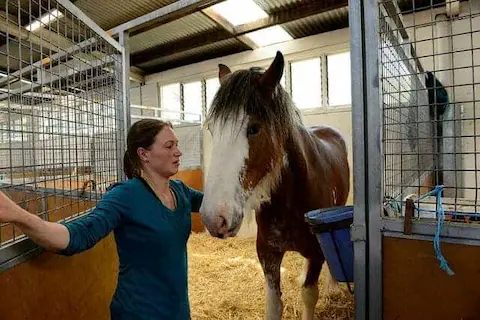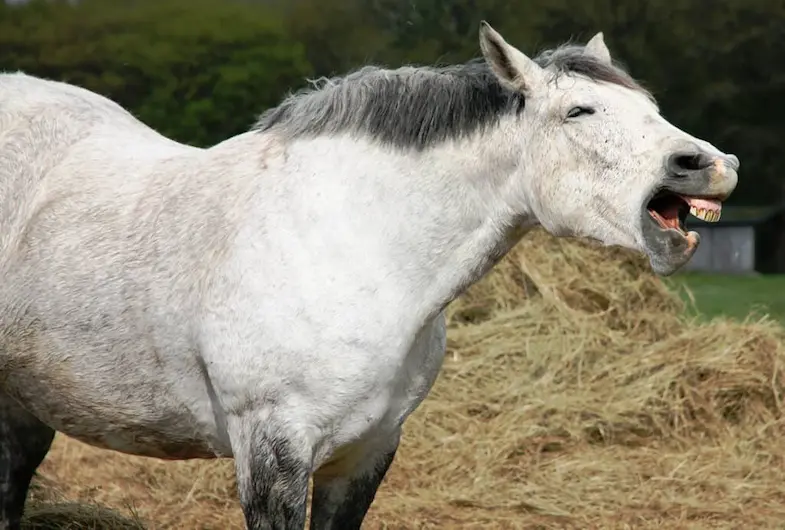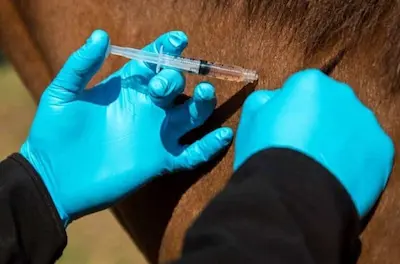Most horse owners will experience equine influenza (EI) at some point in their lives and when you consider that it can be one of the most contagious equine diseases around it’s important to know what to look out for and what steps you can take to reduce the impact of this debilitating disease.
While equine influenza is very rarely fatal it can put a healthy horse out of action for weeks or even months in some extreme cases and with a short incubation period, a whole yard can become infected before you know it. Any horse can suffer from equine influenza but as you would expect younger horses that haven’t developed an immunity are most at risk.
What is equine influenza?
Also known as horse or equine flu, equine influenza is a highly contagious pathogen that affects a horse’s respiratory system. In populations that have no previous exposure to the virus, the infection rate can be as high as 100%.
Considered to be endemic in Europe and North America, equine influenza is enzootic which means that its specific to a particular species (in this case the equine species) and therefore can’t be passed to humans but that doesn’t mean to say that we won’t feel the effects of it, it just won’t affect us physically. While it’s never affected our health, our past reliance on horses for things such as mail delivery and transportation has meant that people’s livelihoods have been disrupted by outbreaks. Even today the sporting and competition calendars have been halted by various outbreaks, the most recent being the UK’s horse racing calendar in 2019.
Is equine influenza contagious?
Every year we complain about how many of us are suffering from whatever strain of human flu is doing the rounds but this is nothing compared to how infectious equine influenza is. As I mentioned earlier its infection rate can be up to 100% but on top of that, it can travel vast distances.
While it can be passed between horses that are up to 150 feet (50 yards) away, this can continue and under the right conditions (or the wrong conditions from our point of view) the virus can be passed from horse to horse to horse and so on for a 3 miles (5km) radius. This, of course, is an extreme example but it’s also a good example of why vaccines are so important.
How is equine influenza transmitted?
Equine influenza can be transmitted between horses both directly and indirectly which is why horses need to be quarantined and a proper hygiene plan implemented.
Just as is the case with human flu, the virus is airborne and can easily be passed by an infected horse, via particles in the environment, to another horse, especially when the infected horse coughs.
It can also be indirectly transmitted by contaminated buckets, brushes, tack, and other stable equipment which is why it’s vital to make sure each horse uses the same equipment every time and they don’t share any equipment. This is generally a good idea anyway but even more important if a horse has equine influenza. We can also carry it from one horse to another on our clothing so should change before visiting a horse that’s free from infection.
What is the incubation period for equine influenza?
One of the reasons why equine influenza can put a whole yard out of action is its incubation period which can be anything from one to five days, although 48 hours is the typical incubation period. Unlike many other diseases and viruses that are no longer infectious after the first symptoms, equine influenza can remain infectious a week after the symptoms first begin to show.
If a horse is immune to equine influenza (either because they’ve recently recovered or have been vaccinated against it) they won’t suffer from any symptoms but they are still able to carry the virus and pass it onto other horses.
What are the symptoms of equine influenza?
Every horse is different and won’t necessarily suffer from all of the same symptoms but the main ones to look out for are:
- A fever between 103°F and 106°F (39°C and 41°C)
- Nasal discharge that can start out thin, watery and clear and within a few days develop into a thick yellow or green discharge
- Frequent hacking cough that’s typically husky and harsh, it can also last for several weeks
- Weakness in everyday activities without an obvious reason
- Depression and lack of interest in anything
- Loss of appetite whether it be they’re completely off of their food or just not eating as much
- Swollen glands especially in the neck under the lower jaw
- Clear eye discharge as well as redness around the eyes
- Swollen limbs mainly in the lower limbs
As soon as you suspect your horse has equine influenza you should keep him away from other horses and speak to your veterinarian for advice and a proper diagnosis. You should also inform the yard owner or manager and let other owners know too.
Even though equine influenza isn’t fatal it can be seriously debilitating for horses and can put them at risk of secondary infections and complications such as pneumonia, muscle soars, inflammation of the heart muscles, and limb swelling as well as other more serious respiratory problems.
How do I treat equine influenza?
Most veterinarians recommend that a horse should be fully rested for at least one week for every day that the horse has a fever, with no fewer than three weeks rest. This is to give the damaged mucociliary apparatus (the three functional compartments that work together to remove inhaled particles from the lungs) enough time to regenerate.
While your horse is resting it’s important that his stable is well ventilated and that there’s minimal exposure to dust particles and spores, this will help to reduce the risk of secondary complications. If the weather is warm enough and not wet and windy then you should also turn your horse out for part of the day once his temperature has returned to normal. As with a well-ventilated stable, this will help to lower the chances of further problems.
Most horses will only have a mild infection and should recover within two weeks, although the cough may last for a number of weeks after the infection has completely cleared up. Some horses though will suffer from a severe infection and this can take up to six months to clear.
In terms of medication, your veterinarian may advise non-steroidal anti-inflammatory drugs if your horse’s temperature is over 104°F (40°C) but because equine influenza is viral and not bacterial antibiotics won’t have any effect. That said though your veterinarian may recommend antibiotics if your horse’s fever lasts for more than three or four days or if there are further complications such as secondary infections like pneumonia.
The equine influenza vaccine
Vaccines are probably the single most important defense against equine influenza as well as being the most effective too. Generally, vaccinations require regular booster shots after the initial course and most veterinarians recommend that a horse has an annual booster vaccination. The virus is continually evolving which is why many countries recommend a horse entering the country to have an up-to-date vaccination card. The FEI (the world authority for many equestrian sports) requires all horses to have a biannual vaccination.
The typical vaccination schedule will look something like this:
- 1st vaccination any time after the age of 5 months
- 2nd vaccination normally 21-92 days after the first vaccination
- 3rd vaccination between 150 and 215 days after the second vaccination
- booster vaccination every 365 days (or 183 days for competition horses)
Just as is the case with human flu, the virus is constantly changing, and as such vaccines may not always work at preventing infection, although they will always help to speed up the recovery time and reduce the severity of the virus.
How to prevent equine influenza
Vaccinations play an important role in reducing the spread of the virus but they should never be relied upon, in conjunction with a vaccination schedule infected horses should immediately be moved into isolation, ideally at least 150 feet (50 yards) away from other horses.
A proper hygiene procedure should also be put in place to control the virus even further. Luckily equine influenza can be easily killed by simple disinfectants so thoroughly cleaning and disinfecting contaminated areas and equipment is essential.
The virus is most commonly introduced by infected horses which is why many yards will require new horses to be isolated for two weeks upon arrival.
While horses are isolated it is important to keep them happy and their stress levels down and while they may be less likely to interact with toys there are things that you can do to prevent stress and reduce their boredom. A horse safe mirror will help to reduce stress and loneliness while lavender (regardless of whether its oil, dried or a spray) will help to relax and calm your horse.
I hope you found this article helpful. If you did I’d be grateful if you could share it please as it would really help me.
Recommended products
Over the years I have tried hundreds of different horsey products, from various blankets and halters to different treats. Some I’ve loved, others I’ve hated but I thought I’d share with you my top all-time favorite products, the ones I never leave the yard without. I’ve included links to the products (which are in no particular order) that I really think are great.
- Horse Knots by Reference Ready – If you’re like me and enjoy pocket reference guides then you’ll love this knot tying guide. These handy cards can easily fit in your pocket or attach to the saddle for quick reference. They’re waterproof, durable and are color coded to make them easy to follow.
- Mane ’n Tail Detangler – Even if you never show your horse you’ll need to detangle his tail from time to time (and possibly his mane too) which is always a challenging chore! I’ve found that if I run a little bit of detangler through my horse’s tails every few days it stops them from getting matted up and makes combing them easy, even if they’re coated in mud. I don’t know if I should admit to this or not but it also works wonders on my hair.
- TAKEKIT Pro clippers – Over the years I’ve tried a lot of different clippers and while some were obviously better than others I found these to be by far the best. They are heavier than a lot of other clippers but for me, that’s a good thing, it makes them feel more sturdy and hardwearing. On top of that they have a range of speeds so are just as good for clipping your horse’s back as they are his face. I also like the fact that they come in a handy carry case but that’s not for everybody. The company that makes them is super good and incredibly helpful too, a real bonus these days. The only thing I wasn’t keen on was the fact that it doesn’t come with any oil, but that’s not a major problem as it’s not difficult to buy lubricant.
- Shire’s ball feeder – There are so many boredom buster toys out there but I like to use these every day, regardless of whether or not my horses are bored. I find that it helps to encourage my horses to problem solve by rewarding them with treats (or pieces of fruit) but it also mimics their natural grazing behavior which helps to keep them calm and de-stressed.
- Horse safe mirror – This is a strange one that many people are surprised about but I like to put horse safe mirrors in the trailers as well as in the quarantine stalls. It helps to prevent the feeling of isolation by giving the impression of other horses being around. Being herd animals horses can get extremely stressed when they feel that they’re on their own but with these stick-on mirrors, they believe that at least one other horse is with them.
- Rectal thermometer – I know this isn’t glamourous at all but it’s vital for your horse’s well-being to be able to check their temperature and a rectal thermometer is the easiest way of doing this which is why I’ve added it to the list.
Shopping lists
I’ve also put together a few shopping lists of essential items that I’ve found helpful over the years. I’ve broken the lists down into different categories rather than put everything in one massive list 😉



